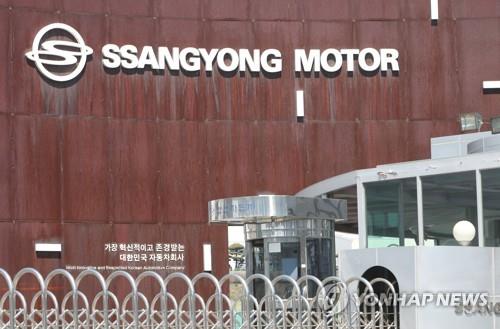- California Assembly OKs highest minimum wage in nation
- S. Korea unveils first graphic cigarette warnings
- US joins with South Korea, Japan in bid to deter North Korea
- LPGA golfer Chun In-gee finally back in action
- S. Korea won’t be top seed in final World Cup qualification round
- US men’s soccer misses 2nd straight Olympics
- US back on track in qualifying with 4-0 win over Guatemala
- High-intensity workout injuries spawn cottage industry
- CDC expands range of Zika mosquitoes into parts of Northeast
- Who knew? ‘The Walking Dead’ is helping families connect
(2nd LD) Debt-laden SsangYong Motor files for court receivership
Financially-troubled SsangYong Motor Co. said Monday it has filed for court receivership as it struggles with snowballing debts amid the COVID-19 pandemic.
The decision comes after SsangYong Motor, the South Korean unit of Indian carmaker Mahindra & Mahindra Ltd., failed to pay 60 billion won (US$54.8 million) worth of debts to its foreign creditor banks last week.
SsangYong asked the creditors to roll over the loans but failed to obtain approval from the lenders, the company said in a statement. The carmaker also failed to pay 90 billion won due on Monday to its main creditor, Korea Development Bank (KDB).
“The company inevitably decided to file for court receivership as the debt repayment will have a grave impact on business operations,” it said.
SsangYong also received a three-month suspension of its obligation to pay its debts. The company is now aiming to find a new investor in the next three months before the court-led restructuring begins, a company spokesman said.
HAAH Automotive Holdings, Inc., a California company that imports vehicles for the U.S. market, has been reportedly a possible investor in SsangYong. HAAH declined to comment on the matter.


This file photo taken April 5, 2020, shows SsangYong Motor’s plant in Pyeongtaek, 70 km south of Seoul. (Yonhap)
Trading in SsangYong shares was halted on the Korean Stock Exchange immediately after the main stock bourse was closed.
On Monday, SsangYong shares plunged 19 percent to 2,770 won, far underperforming the broader KOSPI’s 0.2 percent gain.
The SUV-focused carmaker logged net losses in the past 15 consecutive quarters through the third quarter of this year due to lack of new models and tougher competition with local rivals.
Its vehicle sales fell 19 percent on-year to 96,763 units in the January-November period from 119,876 a year earlier.
SsangYong’s lineup consists of the flagship G4 Rexton, as well as the Tivoli, Korando and Rexton Sports.
This is the second time for SsangYong to place itself under court receivership after undergoing the same process a decade ago.
China-based SAIC Motor Corp. acquired a 51 percent stake in SsangYong in 2004 but in 2009 relinquished its control of the carmaker in the wake of the economic downturn.
Court receivership is one step short of bankruptcy in South Korea’s legal system. In receivership, the court will decide whether and how to revive the company.
In 2011, Mahindra acquired a 70 percent stake in SsangYong for 523 billion won and now holds a 74.65 percent stake in the carmaker.
Mahindra has said it does not have a plan to inject fresh capital into SsangYong and will give up its status as the biggest shareholder of the Korean unit if it finds a new investor.
Mahindra said early this year it would inject 230 billion won into SsangYong for the following three years after obtaining approval from its board. But its board voted against the investment plan last month as the spreading COVID-19 outbreak continues to affect vehicle sales in global markets.
Instead of the proposed 230 billion won, Mahindra said it would consider a “special one-time infusion” of up to 40 billion won over the next three months to help SsangYong continue operations.
The one-time cash injection falls far short of the 500 billion won Mahindra Managing Director Pawan Goenka had said is needed to turn SsangYong around by 2022.
In August, KPMG Samjong Accounting Corp., the auditor of SsangYong, declined to give its opinion on the carmaker’s earnings results for the January-June period.
If Samjong gives no opinion on SsangYong’s annual financial statements for the year, the company can appeal the decision within a week and will be given one year to improve its financial health.
SsangYong could be delisted if its accountant again refuses to offer an opinion on the company’s annual performance for the following year after the one-year period.











